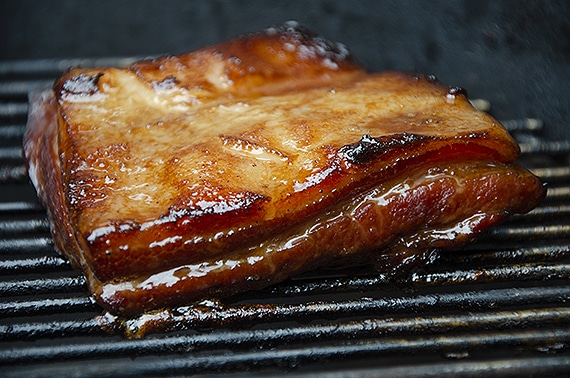Classic Traditional American Bacon Recipe
4.6
(648)
Your folders
Your folders
Prep Time: 30 minutes
Cook Time: 120 minutes
Total: 4470 minutes
Servings: 75

Ingredients
Export 2 ingredients for grocery delivery
Instructions
Step 1
Skin it. If the skin is still on the belly, remove it and use it to make cracklins. It is sometimes hard to tell if it is still there. It is usually a darker tan color compared to creamy colored fat. You should be able to make a cut in fat with your thumbnail. Your thumbnail will only make a dent in skin. Leaving skin on causes problems for salt penetration, and when you fry it, the skin gets very hard and you probably won't like the texture. Removing the skin can be tricky. Sometimes you can grip a corner with your fingers and run a knife under the skin to peel it back by running the knife between the skin and fat. Sometimes you just have to shave it off with a sharp knife.
Step 2
Cure it. Pour everything except the meat into a zipper bag large enough to hold the belly. A 1 gallon (4 L) bag will hold a single 3 pound (1.4 kg) slab. Zip the bag and squish everything around until well mixed. Now add the belly, squeeze out the air as much as possible and squish some more rubbing the cure into the belly and coat all sides. Put the bag in a pan to catch leaks and place in the fridge at 34 to 38°F (1.1 to 3.3°C). The belly will release liquid so every day or two you want to gently massage the bag so the liquid and spices are well distributed, and flip the bag over. NOTE: If you use more than one slab in a bag it is crucial that the slabs do not overlap each other. Thickness matters!
Step 3
Rinse off the cure. Remove the belly from the bag, and throw the liquid away. Quick rinse it to wash off any thick deposits of salt on the surface. Most recipes tell you to let the slab dry for 24 hours so the smoke will stick better, but, as the AmazingRibs.com science advisor Dr. Greg Blonder has proven, smoke sticks better to wet surfaces, so this extra step isn't necessary.
Step 4
Fire up. If you are using a grill, set up for 2-zone cooking or fire up your smoker.
Step 5
Cook. Smoke over indirect heat at 225°F (107.2°C) until the internal temp is 150°F (65.6°C), about 2 hours. You can use any wood you like. Hickory is the tried and true. I'm partial to cherry and applewood. After smoking you should slice off the ends, which may be very dark and more heavily seasoned, and taste them right away. They will be more salty than the innards and the fat will be a bit stringy, but you'll love it all the same. Just wait til you cook up an inside slice!
Step 6
Cool. Now let it cool on a plate in the fridge. Cold bacon is easier to slice. Use on a slicer if you have one, or use a long thin knife to slice it. Try some thin and some thick slices. You can also cut bacon in cubes to make lardons and use them like bacon bits in salads, mashed potatoes, mac and cheese, baked beans, in sauces or to garnish chops, or roasts.
Step 7
Wrap it tightly with several layers of plastic wrap, and then a layer of foil, and refrigerate for up to 2 weeks or freeze for up to 3 months. Do not wrap in foil alone because it can react with the salt.
Step 8
Slice. Slice it across the grain. For evenly thick slices, a slicing machine is the best choice, but I rarely use mine because it is a pain to clean. Besides, I like to keep the slab intact and tightly wrapped in the fridge or freezer to reduce exposure to oxygen which can make the fat taste funny in a week or two. When I make bacon I usually shoot for hunks 6 to 8" (15.2 to 20.3 cm) wide across the grain to make sure my thin 9" (22.9 cm) knife and frying pan fit. If you put a slab in the freezer for 15 minutes or so it gets stiffer and easier to slice.
Step 9
Cook. When you are hungry, cook it just like you do store bought bacon. Or make candied bacon like in this video.
Step 10
Save the bacon drippings. While your bacon is cooking lay out a section of newspaper several sheets thick, and cover it with a layer of paper towels. As soon as the bacon is done, move it to the paper towel to drain. Let the fat in the pan cool a bit and then pour it in a glass jar and refrigerate. Hot bacon can melt a plastic tub, so be careful. Save the fat for up to a month and use it to fry. Broccoli and potatoes are especially good cooked in bacon grease.